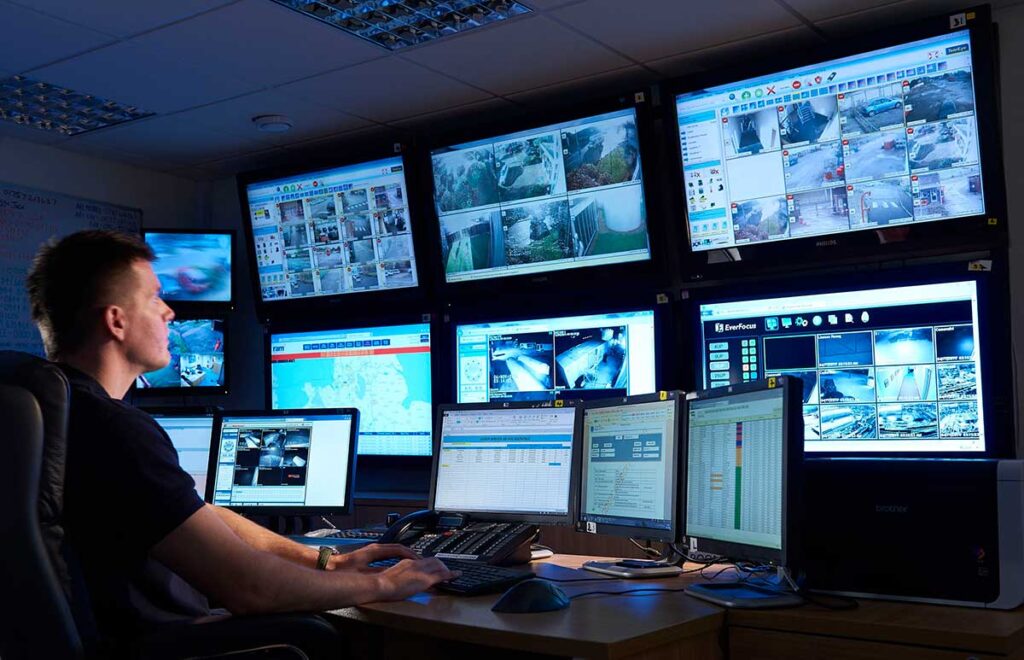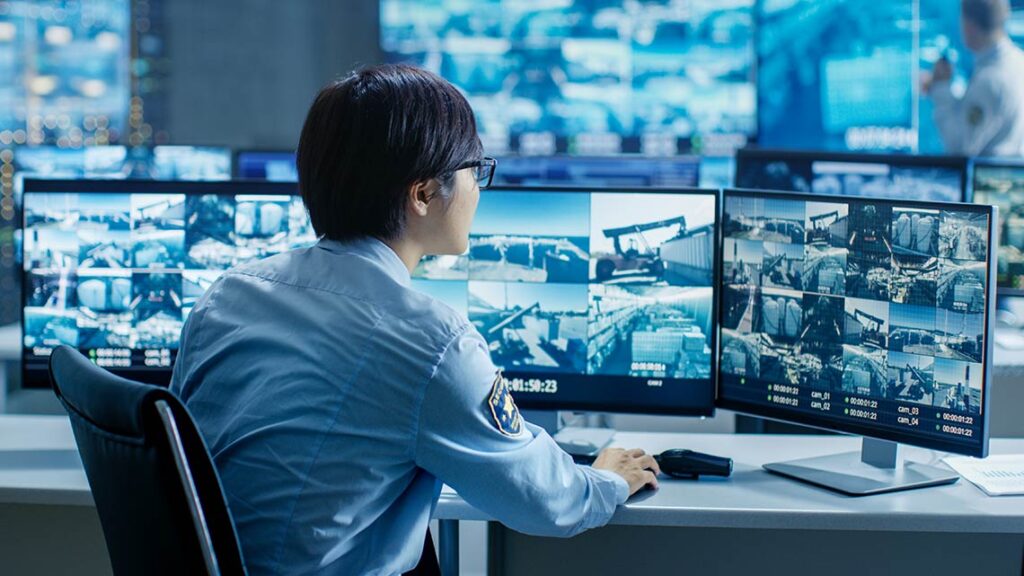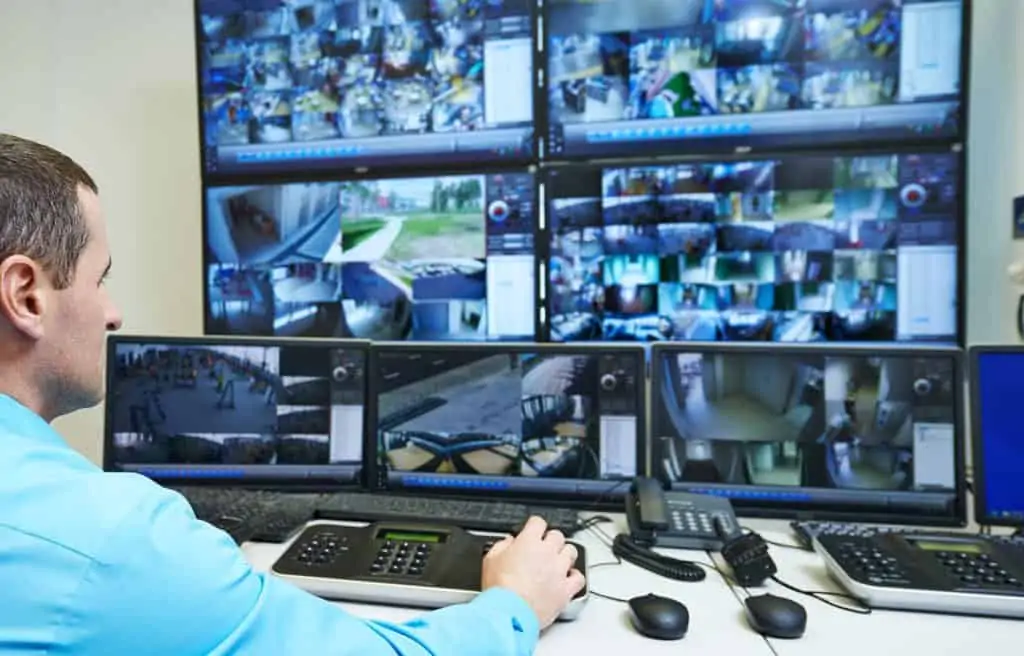Monitored security systems are like watchful guardians for properties, providing constant protection through integrated electronic services. These advanced systems can detect intruders, monitor activities, and respond to security concerns in real-time, making them a strong defence against potential threats.
What Does a Monitored Security System Include?
A comprehensive monitored security system includes several important parts:
- Surveillance Cameras (CCTV) – High-resolution video monitoring with cloud connectivity
- Motion Detectors – Advanced sensors for movement detection
- Access Control Systems – Secure entry management through keypads, cards, or biometric scanners
- Alarm Systems – Immediate threat detection with automated response protocols
- 24/7 Monitoring Centre – Professional surveillance and emergency response coordination
What Are the Benefits of Monitored Security Systems?
The integration of monitored security systems into properties brings significant advantages for both residential and commercial settings:
- Enhanced protection against break-ins and vandalism
- Real-time alerts and emergency response capabilities
- Remote monitoring through mobile applications
- Valuable evidence collection for security incidents
- Potential reduction in insurance premiums
- Peace of mind for property owners and occupants
How Do Modern Monitored Security Systems Work?
Modern monitored security systems adapt to specific property needs, whether it’s securing a family home or safeguarding a large commercial facility. These systems work well with smart home technologies, creating an intelligent security network that can adjust to changing safety requirements while still being easy to use.
Assessing Security Needs for Your Property
A thorough security needs assessment forms the foundation of an effective monitored security system. The evaluation process requires careful consideration of multiple factors specific to each property.
Property Layout Analysis
- Building dimensions and floor plans
- Entry and exit points
- Blind spots and concealed areas
- Landscape features affecting visibility
- Adjacent properties and shared spaces
Critical Asset Identification
- High-value equipment and inventory
- Sensitive data storage areas
- Cash handling locations
- Restricted access zones
- Utility infrastructure points
Risk Assessment Checklist
- Historical crime rates in the area
- Past security incidents on the property
- Peak activity hours and usage patterns
- Staff or resident occupancy levels
- Environmental hazards
It’s essential to conduct a comprehensive risk assessment, which can be facilitated by following guidelines such as those outlined in this NIST special publication. This document provides valuable insights into assessing various risks associated with your property.
Regulatory Requirements
- Industry-specific security standards
- Local building codes
- Insurance policy mandates
- Data protection regulations, including those outlined in data protection impact assessment templates, which are crucial for properties handling sensitive information.
- Emergency response protocols
The assessment should account for both internal and external threats. A retail property might prioritise surveillance of customer areas and stockrooms, while a residential complex may focus on perimeter security and access control systems.
A professional security audit can reveal vulnerabilities that might be overlooked during casual observation. These assessments often uncover critical weak points such as inadequate lighting, unsecured maintenance access, or outdated locking mechanisms that require immediate attention.
Understanding Components of Monitored Security Systems
A monitored security system consists of multiple integrated components working together to create a comprehensive security solution.
Surveillance Cameras (CCTV)
- High-Resolution Cameras: 4K resolution cameras with night vision capabilities for crystal-clear footage
- PTZ Cameras: Pan-tilt-zoom functionality for dynamic monitoring of large areas
- Dome Cameras: Discreet surveillance suitable for indoor spaces
- Bullet Cameras: Weather-resistant options for outdoor perimeter monitoring
Intrusion Detection Sensors
- Motion Sensors: PIR technology detecting movement within specified zones
- Glass Break Detectors: Acoustic sensors identifying the sound frequency of breaking glass
- Door/Window Contacts: Magnetic sensors alerting when entry points are breached
- Vibration Sensors: Detection of forceful attempts to break through walls or barriers
Access Control Mechanisms
- Card Readers: RFID or magnetic stripe systems for controlled entry
- Biometric Scanners: Fingerprint or facial recognition for high-security areas
- Keypad Systems: PIN-based access with customisable user permissions
- Mobile Access: Smartphone-based entry systems with encrypted credentials
Alarm Systems
- Control Panels: Central hub managing all security components
- Sirens: High-decibel audio alerts deterring intruders
- Strobe Lights: Visual warning signals during security breaches
- Mobile Notifications: Real-time alerts sent directly to connected devices
- Back-to-Base Monitoring: Direct connection to security response centres
Each component can be customised based on specific security requirements and integrated into a unified system for seamless operation and management.
Types of Monitored Security Systems
Modern security solutions range from basic standalone systems to sophisticated integrated platforms. Understanding these options helps property owners make informed decisions based on their specific needs.
Standalone Security Systems
Standalone systems serve as fundamental property protection tools:
1. Basic Alarm Systems
- Motion sensors and door contacts
- Local sirens for intruder deterrence
- Mobile notifications through dedicated apps
- Battery backup capabilities
2. Video Doorbells
- HD video and two-way audio communication
- Motion-activated recording
- Night vision capabilities
- Cloud storage for footage
Integrated Smart Security Solutions
Smart home security systems deliver comprehensive protection through seamless component integration:
1. Core Features
- Central hub controlling multiple devices
- Remote management via smartphone apps
- Automated routines and schedules
- Real-time alerts and notifications
2. Advanced Capabilities
- Voice control through virtual assistants
- Environmental monitoring (smoke, carbon monoxide)
- Smart lighting integration
- Automated door locks
- Temperature and humidity sensors
- Energy management features
These integrated systems adapt to varying security needs while offering scalability for future expansions. The interconnected nature of smart security solutions enables property owners to monitor and control their security setup from anywhere, creating a robust defence against potential threats.
Monitoring Options: Self-Monitored vs. Professional Monitoring Services
Self-monitored security systems connect directly to mobile devices through dedicated apps, putting control directly in the property owner’s hands. These systems send real-time alerts and live video feeds when triggered, allowing users to assess situations and decide appropriate actions.

Self-Monitoring Characteristics:
- Direct smartphone notifications
- Live video streaming capabilities
- No monthly monitoring fees
- Personal responsibility for emergency response
- Requires constant internet connectivity
- Limited to user availability and response
Professional monitoring services maintain constant vigilance, with typical response times under 30 seconds for alarm verification and emergency dispatch. Click here to learn about how home security camera installation can deter break-ins.
Professional Monitoring Benefits:
- 24/7 dedicated monitoring centre staffing
- Trained security professionals handling alerts
- Direct communication with emergency services
- Backup monitoring during power/internet outages
- Verified response protocols
- Regular system health checks
Response time marks a critical difference between these options. Self-monitored systems rely on the user’s ability to check notifications and react promptly.
Reliability factors also differ significantly. Self-monitoring depends on stable internet connections and user attention, which can be compromised during travel or busy periods.
The choice between these options often balances cost considerations against desired security levels. Self-monitoring eliminates monthly fees but demands more personal involvement, while professional monitoring provides comprehensive protection with the assurance of expert intervention.
Installation Considerations for Monitored Security Systems
The method of installation chosen for a security system affects how well it works and how dependable it is. Both DIY and professional installations have their own advantages and challenges.
Benefits of DIY Installation:
- Cost-effective solution without labour fees
- Flexible installation timeline
- Direct system familiarity
- Simple wireless systems suitable for DIY
Challenges of DIY Installation:
- Risk of incorrect component placement
- Limited technical support
- Potential warranty implications
- Time-consuming learning curve
Advantages of Professional Installation:
- Expert system configuration
- Optimal component positioning
- Full warranty coverage
- Technical support availability
- Proper wire concealment
Drawbacks of Professional Installation:
- Higher upfront costs
- Scheduling dependencies
- Limited control over installation process
The complexity of the security system plays a crucial role in the installation decision. Basic wireless systems with minimal components suit DIY enthusiasts, while integrated systems with multiple sensors, cameras, and access points benefit from professional expertise. Properties with specific wiring requirements or architectural challenges require professional assessment to ensure proper system functionality and aesthetic integration.
Scalability, Budgeting, Brand Reputation & Service Provider Selection for Monitored Security Systems
System Scalability
Modular security system designs enable property owners to expand protection as needs evolve. Key scalability features include:
- Open architecture platforms supporting third-party device integration
- Expandable control panels with additional zone capacity
- Cloud storage options with flexible data retention periods
- API compatibility for future smart home integrations
Cost Analysis & Budgeting
A comprehensive security investment encompasses several cost elements:
Initial Expenses
- Equipment costs: £500-£3000+
- Installation fees: £200-£800
- System programming: £100-£300
Recurring Costs
- Monthly monitoring: £20-£50
- Cloud storage: £5-£25
- Maintenance: £100-£300 annually
- Battery replacements: £20-£50 per device
Potential Savings
- Insurance premium reductions: 5-20%
- Tax deductions for business installations
- Reduced security staff requirements
- Prevention of theft-related losses
It’s noteworthy that the integration of advanced security systems could lead to substantial insurance premium reductions, further enhancing cost-effectiveness.
Evaluating Brands & Providers
Brand Assessment Criteria
- Market presence duration
- Product warranty terms
- Technical support availability
- Software update frequency
- Third-party certifications
Service Provider Selection A reliable security provider should demonstrate:
- Valid security licenses
- Professional certifications
- Comprehensive insurance coverage
- Documented emergency response protocols
- Transparent service level agreements
Due Diligence Steps
- Review customer testimonials
- Check industry ratings
- Verify business registration
- Examine complaint history
- Request reference contacts
The selection of scalable systems from reputable providers creates a foundation for long-term security success. Professional monitoring services enhance system effectiveness through rapid incident response and regular maintenance support.

Conclusion
Selecting the right monitored security system is a critical investment in protecting your property. Professional security consultants bring invaluable expertise to this decision-making process through:
- Understanding of new security technologies
- Ability to assess risks thoroughly
- Knowledge of industry compliance requirements
- Experience in matching solutions to specific property needs
A tailored security approach, developed with expert guidance, ensures comprehensive protection while avoiding costly oversights or unnecessary features. These specialists can identify potential weaknesses that property owners might overlook and recommend appropriate countermeasures.
The process of choosing the right monitored security system requires careful consideration of multiple factors – from technical specifications to long-term maintenance requirements. Working with qualified security professionals helps navigate these complexities, resulting in a strong security solution that brings peace of mind and reliable protection for years to come.

